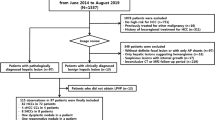Abstract
Purpose
To examine the differential features of focal eosinophilic liver disease (FELD) from liver metastases on gadoxetic acid-enhanced MRI.
Materials
Twenty patients with 41 FELD and 20 patients with 55 metastases were enrolled in this study. Liver MRI consisted of precontrast 2D T1-weighted image (T1WI) and gadoxetic acid-enhanced 3D T1WI (arterial, portal, 20 min hepatocyte-selective phases), and a postcontrast T2WI. Images were analyzed for the margin and shape of the lesions; lesion conspicuity on T1- and T2WI; signal intensity of the lesions on 3D T1WI; presence of rim enhancement and misty signs; and presence of significant smaller lesions on the unenhanced T1WI (<50%) compared to hepatocyte phase image.
Results
Univariate analysis revealed the following significant parameters to favor FELD: a fuzzy margin, irregular shape, subtle signal intensity changes on T1- and T2WI, absence of target signs on the hepatocyte phase image, presence of misty signs, and size discrepancies on T1WI and hepatocyte phase images. Multivariate analysis revealed only a significantly smaller lesion size on T1WI compared to hepatocyte phase images to be predictive of FELD.
Conclusion
A significantly smaller lesion size on T1WI relative to hepatocyte phase image is the best predictor for identifying FELD on gadoxetic acid-enhanced MRI.



Similar content being viewed by others
References
Kim GB, Kwon JH, Kang DS (1993) Hypereosinophilic syndrome: imaging findings in patients with hepatic involvement. AJR Am J Roentgenol 161:577–580
Yoon IL (1959) The eosinophil and gastrointestinal carcinoma. Am J Surg 97:195–200
Iwasaki K, Torisu M, Fusimura T (1986) Malignant tumor and eosinophils. Cancer 58:1321–1327
Soon WH, Kim HG, Park CI, Lee SI (1993) Eosinophilic liver abscess in patients with gastric cancer. Korean J Pathol 27:27–33
Lee WJ, Lim HK, Lim JH, et al. (1999) Foci of eosinophil-related necrosis in the liver: imaging findings and correlation with eosinophilia. AJR Am J Roentgenol 172:1255–1261
Choi JI, Lee JM, Kim SH, et al. (2009) Differentiating focal eosinophilic necrosis of the liver from hepatic metastases using unenhanced and portal venous phase computed tomographic imagings: results of univariate and multivariate statistical analyses. J Comput Assist Tomogr 33:705–709
Kim TH, Kim JK, Lee JH, et al. (2009) Focal eosinophilic infiltration versus metastasis in the liver: comparison of MRI findings. Hepatogastroenterology 56:1471–1476
Hur J, Park MS, Yu JS, et al. (2005) Focal eosinophilic necrosis versus metastasis in the liver: the usefulness of two-phase dynamic CT. AJR Am J Roentgenol 184:1085–1090
Cho ES, Yu JS, Kim MJ, et al. (2010) Focal eosinophilic necrosis on superparamagnetic iron oxide-enhanced MRI. AJR Am J Roentgenol 194:1296–1302
Sun JS, Kim JK, Won JH, et al. (2005) MR findings in eosinophilic infiltration of the liver. J Comput Assist Tomogr 29:191–194
Kim YK, Kim CS, Moon WS, et al. (2005) MRI findings of focal eosinophilic liver diseases. AJR Am J Roentgenol 184:1541–1548
Hong SW, Cho MY, Park C (1999) Expression of eosinophil chemotatic factors in stomach cancer. Yonsei Med J 40:131–136
Lim JH, Lee KS (2006) Eosinophilic infiltration in Korea: idiopathic? Korean J Radiol 7:4–6
Huppertz A, Haraida S, Kraus A, et al. (2005) Enhancement of focal liver lesions at gadoxetic acid-enhanced MR imaging: correlation with histopathologic findings and spiral CT—initial observations. Radiology 234:468–478
Kim YK, Kim CS, Han YM, et al. (2010) Comparison of gadoxetic acid-enhanced MRI and superparamagnetic iron oxide-enhanced MRI for the detection of hepatocellular carcinoma. Clin Radiol 65:358–365
Vogl TJ, Kummel S, Hammerstingl R, et al. (1996) Liver tumors: comparison of MR imaging with Gd-EOB-DTPA and Gd-DTPA. Radiology 200:59–67
Kim YK, Lee YH, Kwak HS, Kim CS, Han YM (2010) Detection of liver metastases: Gadoxetic acid-enhanced three-dimensional MR imaging versus ferucarbotran-enhanced MR imaging. Eur J Radiol 73:131–136
Lee J, Park CM, Kim KA, Lee CH, Choi JW (2010) MR findings of focal eosinophilic liver disease using gadoxetic acid. Magn Reson Imaging 28:1327–1334
Tanimoto A, Lee JM, Murakami T, et al. (2009) Consensus report of the 2nd International Forum for Liver MRI. Eur Radiol 19 Suppl 5:S975–S989
Shanti CM, Lucas CE, Tyburski JG, Soulen RL, Lucas DR (2001) Eosinophilic abscess and eosinophilic pseudotumor resenting as bile duct masses: a report of 2 cases. Surgery 130:104–108
Kaplan KJ, Goodman ZD, Ishak KG (2001) Eosinophilic granuloma of the liver. A characteristic lesion with relationship to visceral larva migrans. Am J Surg Pathol 25:1316–1321
Gabata T, Matsui O, Kadoya M, et al. (1998) Delayed MR imaging of the liver: correlation of delayed enhancement of hepatic tumors and pathologic appearance. Abdom Imaging 23:309–313
Kim YK, Lee JM, Kim CS (2004) Gadobenate dimeglumine-enhanced liver MR imaging: value of dynamic and delayed imaging for the characterization and detection of focal liver lesions. Eur Radiol 14:5–13
Author information
Authors and Affiliations
Corresponding author
Rights and permissions
About this article
Cite this article
Kim, Y.K., Lee, Y.H., Kim, C.S. et al. Differentiating focal eosinophilic liver disease from hepatic metastases using unenhanced and gadoxetic acid-enhanced MRI. Abdom Imaging 36, 425–432 (2011). https://doi.org/10.1007/s00261-011-9752-7
Published:
Issue Date:
DOI: https://doi.org/10.1007/s00261-011-9752-7




